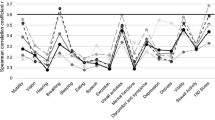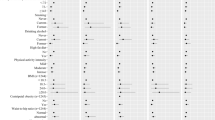Abstract
Background: Patients with chronic illness use health services more often but little is known about the use that coronary heart disease patients make of primary care. Objective: To determine whether the time elapsed and the perceived quality of life following a major acute coronary event are associated with utilization rate of primary care services. Design: Cross-sectional, multicentre study. Setting: Twenty-three primary care health centres in Catalonia (Spain). Participants: Patients aged 30–80 years who had suffered a major coronary event in the previous 6 years. Main outcome measures: The number of consultations with the general practitioner during the year before the beginning of the study was noted and patients who consulted nine or more times were considered frequent attenders. The time elapsed since the last major coronary event was categorized using the median (2 years) as a cut-off value. The SF-12 quality of life questionnaire was administered. Results: A total of 1022 patients with coronary heart disease were included. The median number of consultations with a general practitioner within the previous year was 5 (range 0–36). Patients with a shorter time elapsed since the last coronary event were seen more often by their general practitioner. The probability of being frequent attender was 24% lower among patients with less recent coronary events (adjusted odds ratio: 0.76, 95% confidence interval: 0.69–0.85, p < 0.001). Quality of life scores were similar in frequent and non-frequent attenders. No relationship between comorbidity and frequent attendance was found. Conclusions: The shorter time elapsed since the last coronary event was an important factor related with frequent attendance in coronary heart disease patients regardless of cardiovascular comorbidity, and perceived quality of life.
Similar content being viewed by others
References
JA Muir Grey (1997) Evidence-based healthcare How to make health policy and management decisions. Pearson Professional Limited London
SH Shapiro G Wilson F Griffith R Oseasohn (1986) ArticleTitleLong-term adult use of ambulatory services provided by physicians in a Canada medical care plan Med Care 24 418–428
Ministerio de Sanidad y Consumo. Proyectos de investigación para el desarrollo del Sistema Nacional de Salud. B.O.E., 1992.
De la Revilla L. Necesidad, demanda y utilización. Modelos explicativos. En Monografías clínicas en Atención Primaria (no. 7). Factores que intervienen en la utilización de los servicios de salud. Barcelona: DOYMA, 1991.
S Dunlop PC Coyte W McIsaac (2000) ArticleTitleSocio-economic status and the utilization of physicians’ services: Results from the Canadian National Population Health Survey Soc Sci Med 51 123–133
R Carr-Hill N Rice M Roland (1996) ArticleTitleSocioeconomic determinants of rates of consultation in general practice based on fourth national morbidity survey of general practices Br Med J 312 1008–1012
RD Neal PL Heywood S Morley AD Clayden AC Dowell (1998) ArticleTitleFrequency of patients’ consulting in general practice and workload generated by frequent attenders: comparisons between practices Br J Gen Pract 48 895–898
DK Freeborn CR Pope JP Mullooloy BH McFarland (1990) ArticleTitleConsistently high users of medical care among the elderly Med Care 28 527–540
JA Bellón A Delgado J Luna P Lardelli (1995) ArticleTitleInfluencia de la edad y el sexo sobre los distintos tipos de utilización en atención primaria Gaceta Sanitaria 9 343–353
Plà de salut de Catalunya 1993–1995. Departament de Sanitat i Seguretat Social. Barcelona: Generalitat de Catalunya, 1993.
JG Maeland OE Havick (1989) ArticleTitleUse of health services after a myocardial infarction Scand J Soc Med 17 93–102
Rubenach B Shadbolt J McCallum T Nakamura (2002) ArticleTitleAssessing health-related quality of life following myocardial infarction: Is the SF-12 useful? J Clin Epidemiol 55 306–309
Wood DA, De Backer G, Faergeman O, Graham I, Mancia G, Pyörälä K, on behalf of the Task Force. Prevention of coronary disease in clinical practice. Recommendations of the Second Joint Task Force of the European Society of Cardiology, European Atherosclerosis Society and European Society of Hypertension. Eur Heart J 1998; 19: 1434–1503.
The Sixth Report of the Joint National Committee on Prevention, Detection, Evaluation, and Treatment of High Blood Pressure. Washington: National Heart, Lung and Blood Institute, 1997.
AJB Brady MA Oliver JB Pittard (2001) ArticleTitleSecondary prevention in 24431 patients with coronary heart disease: survey in primary care Br Med J 322 1463
JE Ware M Kosinski A Keller (1996) ArticleTitleA 12-Item Short-Form Health Survey: Construction of scales and preliminary tests of reliability and validity Med Care 34 220–233 Occurrence Handle10.1097/00005650-199603000-00003 Occurrence Handle8628042
B Gandek J Ware N Aaronson et al. (1998) ArticleTitleCross-validation of item selection and scoring for the SF-12 health survey in nine countries: results from the IQOLA Project J Clin Epidemiol 51 1171–1178 Occurrence Handle10.1016/S0895-4356(98)00109-7 Occurrence Handle1:STN:280:DyaK1M%2Fjt1Shtw%3D%3D Occurrence Handle9817135
S Llorente T López LJ García MP Alonso P Muñoz (1996) ArticleTitlePerfil del hiperfrecuentador de un centro de salud Aten Primaria 17 100–107
A Segovia C Pérez J Torío MC García (1998) ArticleTitleMalestar psíquico y características sociodemográficas y familiares del hiperfrecuentador en atención primaria Aten Primaria 22 562–569
R Manzanera J Berenguer JM Picas J Vilalta (1988) ArticleTitleAnálisis comparativo de los consumos sanitarios en una mutua de filiación obligatoria PAMEN Gaceta Sanitaria 2 135–143
A Grimsmo H Siem (1984) ArticleTitleFactors affecting primary health care utilization Fam Prac 1 155–161
K Baez JM Aiarzaguena G Grandes E Pedrero J Aranguren A Retolaza (1998) ArticleTitleUnderstanding patient-initiated frequent attendance in primary care: A case-control study Br J Gen Pract 48 1824–1827
ES Fisher JE Wennberg TA Stukel SM Sharp (1994) ArticleTitleHospital readmission rates for cohorts of medicare beneficiaries in Boston and New Haven N Engl J Med 331 989–995
D Gómez F Hernández M Gómez (1996) ArticleTitleLa investigación en la utilización de servicios sanitarios Formación Médica Continuada en Atención Primaria 3 229–242
LC Mendes HM Krumholz V Vaccarino et al. (1998) ArticleTitleA population-based perspective of changes in health-related quality of life after myocardial infarction in older men and women J Clin Epidemiol 51 609–616
N Brown M Melville D Gray et al. (1999) ArticleTitleQuality of life four years after acute myocardial infarction: sort form 36 scores compared with a normal population Heart 81 352–358
L Westin R Carlsson B Israelsson R Willenheimer C Cline TF McNeil (1997) ArticleTitleQuality of life in patients with ischaemic heart disease: a prospective controlled study J Intern Med 242 239–247
PP Glasziou S Browmwich RJ Simes (1994) ArticleTitleQuality of life six months after myocardial infarction treated with thrombolytic therapy. AUS-TASk Group. Australian arm of International tPA/SK Mortality Trial Med J Aust 161 532–536
J Kersnik I Svab M Vegnuti (2001) ArticleTitleFrequent attenders in general practice: Quality of life, patient satisfaction, use of medical services and GP characteristics Scand J Prim Health Care 19 174–177
J Marrugat G Sanz R Masia et al. (1997) ArticleTitleSix-month outcome in patients with myocardial infarction initially admitted to tertiary and nontertiary hospitals J Am Coll Cardiol 30 1187–1192
HM Krumholz MJ Radford Y Wang J Chen A Heiat TA Marciniak (1998) ArticleTitleNational use and effectiveness of beta-blockers for the treatment of elderly patients after acute myocardial infarction: National Cooperative Cardiovascular Project JAMA 280 623–629 Occurrence Handle10.1001/jama.280.7.623 Occurrence Handle1:CAS:528:DyaK1cXlslGqsLc%3D Occurrence Handle9718054
JB Levine NA Covino WV Slack et al. (1996) ArticleTitlePsychological predictors of subsequent medical care among patients hospitalized with cardiac disease J Cardiopulm Rehabil 16 109–116
GB Browne B Humphrey R Pallister JA Browne L Shetzer (1982) ArticleTitlePrevalence and characteristics of frequent attenders in a prepaid Canadian family practice J Fam Pract 14 63–71
D Gill M Sharpe (1999) ArticleTitleFrequent consulters in general practice: a systematic review of studies of prevalence, associations and outcome J Psychosom Res 47 115–130
Author information
Authors and Affiliations
Corresponding author
Rights and permissions
About this article
Cite this article
Munoz, MA., Manresa, JM., Espinasa, J. et al. Association of time elapsed since the last coronary event with health services utilization. Eur J Epidemiol 20, 221–227 (2005). https://doi.org/10.1007/s10654-004-6738-6
Received:
Accepted:
Issue Date:
DOI: https://doi.org/10.1007/s10654-004-6738-6




